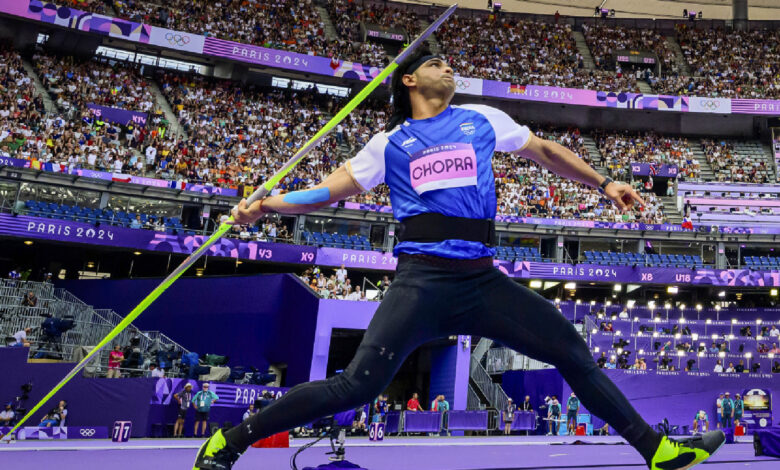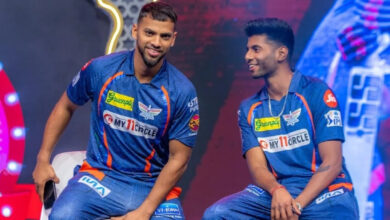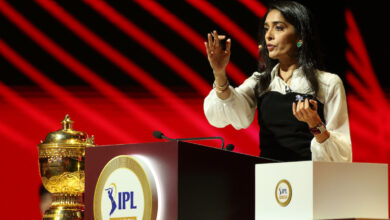Why Neeraj Chopra is unable to breach the 90 metre barrier | Sport-others News

Ishaan Marwaha is talking about a sporting intangible that cannot be measured but only felt: Rhythm. It’s in his head and something he can feel from his vantage point right behind the thrower’s arm. But a hard one for him to articulate.So, when the millions watch in awe as Neeraj Chopra tumbles to the floor and rises with a roar, Marwaha is obsessed with the minutiae.
“I am just watching him how he is warming up,” he says. “Or the technique. How is the leg work? If he is running fast because when he is running slow, we can feel it from outside, there is something wrong. Like it happened in Lausanne…”
Nobody has been as intimate with Chopra as Marwaha. Name a muscle in Chopra’s elastic body and the physiotherap – who’s been with him since 2017, leaving behind his family and travelling the world to train and compete – has likely put optimum pressure on it many times.
So, Marwaha knew something wasn’t right when Chopra sprinted down the runway in Lausanne days after the Paris Olympics. That evening at the Diamond League, he wasn’t seeing the all-conquering champion that Chopra is. Rather, Marwaha was watching an almighty battle between the athlete and his body.
“His body wasn’t functioning,” Marwaha recalls. In the stands, he and Chopra’s coach, Klaus Bartonietz, resigned to the possibility that the world and Olympic medall would finish outside the top three in an international competition for the first time since 2018.
Then, something special happened.
The javelin throwers are a tight-knit bunch. Rio Olympics gold medall Julius Yego noticed Chopra’s struggle and sensed his growing frustration. Yego gave a brief pep talk and urged him to relax before the final throw.
The words of one champion rang in the ears of another and Chopra released the javelin in his signature style – sprinting down the runway, using the full force of his shoulders and falling on his palms in follow-through.
Marwaha (centre) knew something wasn’t right when Chopra sprinted down the runway in Lausanne days after the Paris Olympics. (Instagram)
The spear flew and kept flying. the time it returned to earth, the javelin had travelled a dance of 89.49m, the farthest Chopra had thrown all season.
Even Marwaha, who has seen Chopra pull off superhero stunts in everyday life for the last seven years, was left jaw-dropped. “We were very proud of him,” he gushes. “We told Neeraj, ‘tu agar yeh nikaal sakta hai, toh tu kuch bhi kar sakta hai (If you can do this, you can do anything)।’”
Chasing perfection
That night in Lausanne, we saw Chopra in a new avatar. It was the fighter Neeraj. Days before, in Paris, the world saw angry Neeraj. Anguished, too.
The mood swings have been there for a while. Even after winning the silver medal at the Olympics last month, Chopra was feeling ‘low’, according to Marwaha.
Chopra has reached a stage in his career where medals alone do not thrill him anymore. He’s chasing perfection. “I feel there is a better throw left in me,” he had said after winning the Olympic silver. “Until I don’t get that, shanti nahi mil paegi (I won’t be at peace).”
But the groin injury – about which he spoke in lengthy, emotional monologues in Paris – is restricting him from exploring his full range. The injury lives in Chopra’s head rent-free and consequently, affects his technique.
The groin injury lives in Chopra’s head rent-free and consequently, affects his technique. (PTI)
Marwaha, whose job it has been to keep him match-fit, explains the nature of the much-talked-about adductor. “In layman’s terms, the adductor muscles are attached to our pelvic bone. This attachment is where Neeraj has had a strain,” he tells The Indian Express. “In 2018, he had a Grade 2 injury in the adductor. That muscle healed but after that, repeatedly there has been a strain on the attachment.”
For those who see the world as a glass half full, Chopra’s Olympic silver – responding to Arshad Nadeem’s monster throw with his best of the season until that evening – and Diamond League second place have come despite this injury and living in the constant fear of aggravating it. The possibilities when Chopra is back to his full fitness make many giddy.
Chopra himself has estimated he can add 2 or 3 metres at least if the injury is healed, an assessment Marwaha agrees with.
“He can, definitely! Right now, his throws aren’t right technically. When he throws, he falls towards the left and so, the javelin also travels towards the left. He falls because the block leg isn’t straight when he is releasing, it bends. So, he is not able to put all his force into the javelin,” Marwaha says.
In other words, what the world thought was his signature – falling on the ground while releasing the javelin – is also a red flag; an indication to refine his technique. The fall, Chopra’s one of early-career coaches, Naseem Ahmad, had said wasn’t an occurrence back in those days.
It’s one of the many ways the adductor strain has impacted his technique. And Chopra’s has always been a little different to the others.
Upper-body flexibility, tricky lower body
“He is not a power thrower as the Germans are. He is more of a flexible thrower, so he needs that shoulder flexibility,” Marwaha says. “Other athletes keep the javelin in line with their bodies. But Neeraj’s is a little rotated because he wants that over-stretch of the shoulder. So, we have to work on the shoulder otherwise if that is not mobile and if the range is less, then he will start throwing with the elbow. That increases the chances of an elbow injury. So, we have to take care of the shoulder.”
Then, there’s the leg work, which is where it begins to get tricky.
After the Paris Olympics, Chopra moaned about his reduced speed on the runway. “It’s the right groin that’s under strain. So if his right leg moves fast, the hip moves in faster, definitely you’ll not be stressing your groin,” Marwaha says.
Then, there’s the issue with the left leg, his blocking leg. A block is to javelin what downforce is to a Formula One car in the corners: the throwers run in fast and at the point of release, have to break the speed. If the block is good, more power is transferred to the chest and shoulder, and consequently, the javelin.
In Chopra’s case, the block leg bends and he isn’t able to control the javelin, which veers towards the left – the ‘perfect angle’, Marwaha says, is ‘either at the centre or on the right side up to 45 degrees’. “But if you are going on the left, there is something not right technically,” Marwaha adds.
Chopra touched upon this issue when he gave a brutal assessment of his physical condition in Paris. “Right now, I am forcing myself… when blocking leg and other technical things don’t fall in place, until that point it is very tough to throw. Until the legs don’t support; it’s very tough to rely just on the upper body for full power,” he had said.
His sporting life is playing in a loop. The groin has to get better for Chopra to make the technical adjustments. And the technique must be refined so that the groin doesn’t strain again.
Until they meet the doctors and decide whether to go for surgery, the only target has been to avoid ‘over-stressing’ the groin. For that, Chopra, Marwaha and Bartonietz have begun to limit the throwing sessions. There used to be times when they had two-to-three sessions in a week and per session, there used to be ‘around 30-35 throws; at times, even 40’. Now, it’s reduced to ‘20-25 maybe once or twice a week’.
“So the confidence that is needed to go full throttle… he has to be a little cautious on the runway; ensure his foot is planted properly and the hip rotates in properly so that he doesn’t strain that groin.
“Constantly, in his head, he is thinking I have to move the legs very fast, the hip has to move in so that the groin doesn’t feel the strain and along with all this, he has to make sure that when he is throwing, he doesn’t veer to the left when he releases.”
In simpler terms, to find the rhythm. The intangible Marwaha can feel and obsess over as millions watch in awe of Chopra’s repeated Houdini acts.







